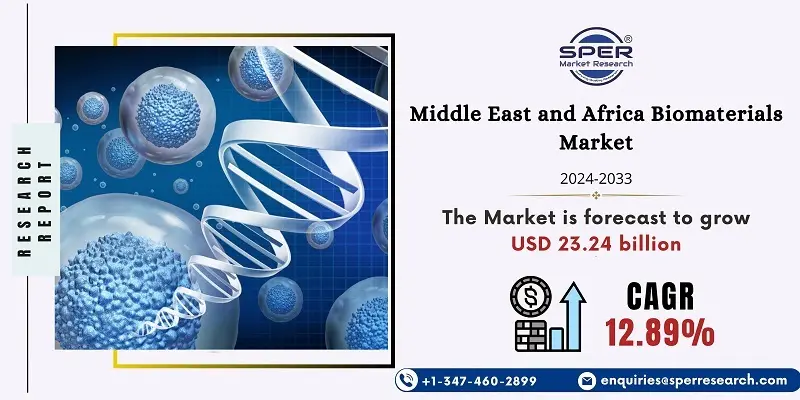
Middle East and Africa Biomaterials Market Growth, Size, Trends, Demand and Future Outlook
Middle East and Africa Biomaterials Market Size- By Material Type, By Application- Regional Outlook, Competitive Strategies and Segment Forecast to 2033
| Published: Apr-2024 | Report ID: HLCA2442 | Pages: 1 - 108 | Formats*: |
| Category : Healthcare | |||


| Report Metric | Details |
| Market size available for years | 2020-2033 |
| Base year considered | 2023 |
| Forecast period | 2024-2033 |
| Segments covered | By Material Type, By Application |
| Regions covered | Eastern, Western, Southern, Northern |
| Companies Covered | BASF SE, Bayer AG, Berkeley Advanced Biomaterials, CAM Bioceramics BV, Carpenter Technology Corporation, Collagen Matrix, Inc., Covalon Technologies Ltd., Corbion N.V., Evonik Industries AG, Royal DSM, Invibio Ltd., Zimmer Biomet Holdings, Inc., Others. |
- Healthcare Industry
- Medical Device Manufacturers
- Pharmaceutical Companies
- Research Institutions and Laboratories
- Academic Institutions
- Regulatory Bodies and Government Agencies
- Biotechnology Companies
| By Material Type: |
|
| By Application: |
|
- Middle East and Africa Biomaterials Market Size (FY’2024-FY’2033)
- Overview of Middle East and Africa Biomaterials Market
- Segmentation of Middle East and Africa Biomaterials Market By Application (Orthopedic, Dental, Cardiovascular, Plastic Surgery, Wound Healing, Ophthalmology, Tissue engineering, Neurological, Others)
- Expansion Analysis of Middle East and Africa Biomaterials Market
- Problems and Obstacles in Middle East and Africa Biomaterials Market
- Competitive Landscape in the Middle East and Africa Biomaterials Market
- Impact of COVID-19 and Demonetization on Middle East and Africa Biomaterials Market
- Details on Current Investment in Middle East and Africa Biomaterials Market
- Competitive Analysis of Middle East and Africa Biomaterials Market
- Prominent Players in the Middle East and Africa Biomaterials Market
- SWOT Analysis of Middle East and Africa Biomaterials Market
- Middle East and Africa Biomaterials Market Future Outlook and Projections (FY’2024-FY’2033)
- Recommendations from Analyst
1.1. Scope of the report1.2. Market segment analysis
2.1. Research data source2.1.1. Secondary Data2.1.2. Primary Data2.1.3. SPER’s internal database2.1.4. Premium insight from KOL’s2.2. Market size estimation2.2.1. Top-down and Bottom-up approach2.3. Data triangulation
4.1. Driver, Restraint, Opportunity and Challenges analysis4.1.1. Drivers4.1.2. Restraints4.1.3. Opportunities4.1.4. Challenges4.2. COVID-19 Impacts of the Middle East and Africa Biomaterials Market
5.1. SWOT Analysis5.1.1. Strengths5.1.2. Weaknesses5.1.3. Opportunities5.1.4. Threats5.2. PESTEL Analysis5.2.1. Political Landscape5.2.2. Economic Landscape5.2.3. Social Landscape5.2.4. Technological Landscape5.2.5. Environmental Landscape5.2.6. Legal Landscape5.3. PORTER’s Five Forces5.3.1. Bargaining power of suppliers5.3.2. Bargaining power of buyers5.3.3. Threat of Substitute5.3.4. Threat of new entrant5.3.5. Competitive rivalry5.4. Heat Map Analysis
6.1. Middle East and Africa Biomaterials Market Manufacturing Base Distribution, Sales Area, Product Type6.2. Mergers & Acquisitions, Partnerships, Product Launch, and Collaboration in Middle East and Africa Biomaterials Market
7.1. Middle East and Africa Biomaterials Market Size, Share and Forecast, By Material Type, 2020-20267.2. Middle East and Africa Biomaterials Market Size, Share and Forecast, By Material Type, 2027-20337.3. Ceramic7.4. Metallic7.5. Polymer7.6. Natural
8.1. Middle East and Africa Biomaterials Market Size, Share and Forecast, By Application, 2020-20268.2. Middle East and Africa Biomaterials Market Size, Share and Forecast, By Application, 2027-20338.3. Orthopedic8.4. Dental8.5. Cardiovascular8.6. Plastic Surgery8.7. Wound Healing8.8. Ophthalmology8.9. Tissue engineering8.10. Neurological8.11. Others
9.1. Middle East and Africa Biomaterials Market Size and Market Share
10.1. Middle East and Africa Biomaterials Market Size and Market Share By Region (2020-2026)10.2. Middle East and Africa Biomaterials Market Size and Market Share By Region (2027-2033)10.3. Southern10.4. Northern10.5. Eastern10.6. Western
11.1. BASF SE11.1.1. Company details11.1.2. Financial outlook11.1.3. Product summary11.1.4. Recent developments11.2. Bayer AG11.2.1. Company details11.2.2. Financial outlook11.2.3. Product summary11.2.4. Recent developments11.3. Berkeley Advanced Biomaterials11.3.1. Company details11.3.2. Financial outlook11.3.3. Product summary11.3.4. Recent developments11.4. CAM Bioceramics BV11.4.1. Company details11.4.2. Financial outlook11.4.3. Product summary11.4.4. Recent developments11.5. Carpenter Technology Corporation11.5.1. Company details11.5.2. Financial outlook11.5.3. Product summary11.5.4. Recent developments11.6. Collagen Matrix, Inc.11.6.1. Company details11.6.2. Financial outlook11.6.3. Product summary11.6.4. Recent developments11.7. Covalon Technologies Ltd.11.7.1. Company details11.7.2. Financial outlook11.7.3. Product summary11.7.4. Recent developments11.8. Corbion N.V.11.8.1. Company details11.8.2. Financial outlook11.8.3. Product summary11.8.4. Recent developments11.9. Evonik Industries AG11.9.1. Company details11.9.2. Financial outlook11.9.3. Product summary11.9.4. Recent developments11.10. Royal DSM11.10.1. Company details11.10.2. Financial outlook11.10.3. Product summary11.10.4. Recent developments11.11. Invibio Ltd.11.11.1. Company details11.11.2. Financial outlook11.11.3. Product summary11.11.4. Recent developments11.12. Zimmer Biomet Holdings, Inc.11.12.1. Company details11.12.2. Financial outlook11.12.3. Product summary11.12.4. Recent developments11.13. Others
SPER Market Research’s methodology uses great emphasis on primary research to ensure that the market intelligence insights are up to date, reliable and accurate. Primary interviews are done with players involved in each phase of a supply chain to analyze the market forecasting. The secondary research method is used to help you fully understand how the future markets and the spending patterns look likes.
The report is based on in-depth qualitative and quantitative analysis of the Product Market. The quantitative analysis involves the application of various projection and sampling techniques. The qualitative analysis involves primary interviews, surveys, and vendor briefings. The data gathered as a result of these processes are validated through experts opinion. Our research methodology entails an ideal mixture of primary and secondary initiatives.



Frequently Asked Questions About This Report
PLACE AN ORDER
Year End Discount
Sample Report
Pre-Purchase Inquiry
NEED CUSTOMIZATION?
Request CustomizationCALL OR EMAIL US
100% Secure Payment






Related Reports
Our Global Clients
Our data-driven insights have influenced the strategy of 200+ reputed companies across the globe.




















